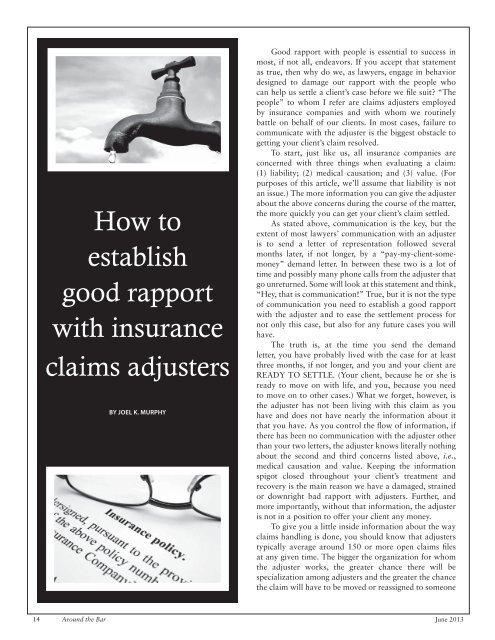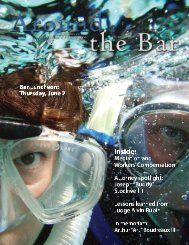to download - Baton Rouge Bar Association
to download - Baton Rouge Bar Association
to download - Baton Rouge Bar Association
You also want an ePaper? Increase the reach of your titles
YUMPU automatically turns print PDFs into web optimized ePapers that Google loves.
How <strong>to</strong><br />
establish<br />
good rapport<br />
with insurance<br />
claims adjusters<br />
BY JOEL K. MURPHY<br />
Good rapport with people is essential <strong>to</strong> success in<br />
most, if not all, endeavors. If you accept that statement<br />
as true, then why do we, as lawyers, engage in behavior<br />
designed <strong>to</strong> damage our rapport with the people who<br />
can help us settle a client’s case before we file suit “The<br />
people” <strong>to</strong> whom I refer are claims adjusters employed<br />
by insurance companies and with whom we routinely<br />
battle on behalf of our clients. In most cases, failure <strong>to</strong><br />
communicate with the adjuster is the biggest obstacle <strong>to</strong><br />
getting your client’s claim resolved.<br />
To start, just like us, all insurance companies are<br />
concerned with three things when evaluating a claim:<br />
(1) liability; (2) medical causation; and (3) value. (For<br />
purposes of this article, we’ll assume that liability is not<br />
an issue.) The more information you can give the adjuster<br />
about the above concerns during the course of the matter,<br />
the more quickly you can get your client’s claim settled.<br />
As stated above, communication is the key, but the<br />
extent of most lawyers’ communication with an adjuster<br />
is <strong>to</strong> send a letter of representation followed several<br />
months later, if not longer, by a “pay-my-client-somemoney”<br />
demand letter. In between these two is a lot of<br />
time and possibly many phone calls from the adjuster that<br />
go unreturned. Some will look at this statement and think,<br />
“Hey, that is communication!” True, but it is not the type<br />
of communication you need <strong>to</strong> establish a good rapport<br />
with the adjuster and <strong>to</strong> ease the settlement process for<br />
not only this case, but also for any future cases you will<br />
have.<br />
The truth is, at the time you send the demand<br />
letter, you have probably lived with the case for at least<br />
three months, if not longer, and you and your client are<br />
READY TO SETTLE. (Your client, because he or she is<br />
ready <strong>to</strong> move on with life, and you, because you need<br />
<strong>to</strong> move on <strong>to</strong> other cases.) What we forget, however, is<br />
the adjuster has not been living with this claim as you<br />
have and does not have nearly the information about it<br />
that you have. As you control the flow of information, if<br />
there has been no communication with the adjuster other<br />
than your two letters, the adjuster knows literally nothing<br />
about the second and third concerns listed above, i.e.,<br />
medical causation and value. Keeping the information<br />
spigot closed throughout your client’s treatment and<br />
recovery is the main reason we have a damaged, strained<br />
or downright bad rapport with adjusters. Further, and<br />
more importantly, without that information, the adjuster<br />
is not in a position <strong>to</strong> offer your client any money.<br />
To give you a little inside information about the way<br />
claims handling is done, you should know that adjusters<br />
typically average around 150 or more open claims files<br />
at any given time. The bigger the organization for whom<br />
the adjuster works, the greater chance there will be<br />
specialization among adjusters and the greater the chance<br />
the claim will have <strong>to</strong> be moved or reassigned <strong>to</strong> someone<br />
14 Around the <strong>Bar</strong><br />
June 2013
















